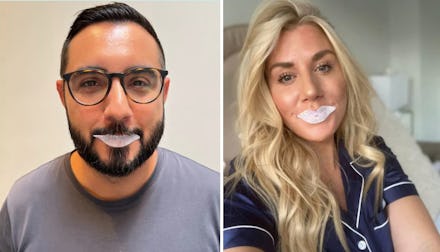What’s nasal breathing? Why it might be the answer to better sleep and less snoring
Reviewers are calling this science-backed sleep hack a game-changer.

Over a quarter of adults aren’t getting the recommended seven hours of sleep per night, according to the CDC — but that’s not for a lack of trying. The internet is filled with tips and tricks to improve your sleep quality, and most people are probably already familiar with many of them: Lower the thermostat; go to bed at the same time every night; don’t drink coffee after 4 p.m.; don’t eat a large meal before bed. One thing you don’t hear a lot about, though? Nasal breathing, and according to reviewers who have tried Dryft sleep strips, which promote nasal breathing for those not naturally inclined, it’s the one sleep hack that finally did the trick.
The science behind nasal breathing
I first heard about nasal breathing on a Huberman Lab podcast episode about science-backed tools for sleep, but the practice is still gaining recognition — a surprise given the scientific findings. In studies, nasal breathing has been shown to improve sleep apnea, increase airflow, minimize snoring, and even reduce stress. In short, breathing through your mouth results in shallow breaths filled with unfiltered air, while breathing through the nose filters the air, expands the lungs, and stimulates your parasympathetic nervous system, which prompts your body’s ability to relax and repair itself.
According to Dryft Sleep, up to 80% of people breathe through their mouths at night — but by encouraging nasal breathing, you may experience less snoring and a deeper, more restful sleep. Other more surprising potential benefits? Nasal breathing may minimize dry mouth, reduce drooling, and lessen brain fog by boosting oxygen uptake.
How does mouth tape work?
Similar to nasal strips, sleep strips have a peel-off back that reveals an adhesive, so you can securely apply the strip before bed — but unlike a nasal strip, these don’t go over your nose; they go over your mouth instead.
The medical-grade tape (which is made of aesthetician-approved silicone for sensitive skin) keeps your mouth closed while you sleep, which is meant to encourage you to breathe through your nose instead. While nasal breathing is the ultimate goal, the mouth tape design does feature a tiny breathing vent over your lips, which allows for mouth-breathing in case your nose is stuffy or you’re having trouble getting used to the practice.
FAST FACTS
- Mouth tape strips that encourage nasal breathing
- Medical-grade adhesive that’s safe for sensitive skin
- Lip-shaped design that features a mouth breathing vent for greater comfort
- 30 individually wrapped, single-use strips in each order
- Free shipping
- Money-back guarantee
What Are Reviewers Saying?
Full disclosure: I haven’t tried these strips myself, but the reviews are pretty promising. So far, they’ve earned only five-star ratings and are 100% recommended by past buyers (and if that sounds too good to be true, the brand is committed to transparency and only shares authentic reviews from Thingtesting and Okendo).
Several buyers commented that the strips “help [them] fall and stay asleep.” One reviewer in particular wrote, “Absolutely loving my Dryft strips. I’m getting deeper sleep and dreaming like I’ve never had before. Waking up with a clearer mind and feeling less anxious.”
Others reported that it “helps with [their] snoring” and their “mouth is no longer dry when [they] wake up.” Finally, even those with especially sensitive skin haven’t experienced any irritation: “It doesn't extend too far along the delicate skin around my lips or cause irritation, but is still super effective.”
Plus, delivery is free and if it’s not for you, the company backs its products with a 100%.
Sources:
André, C. (2019, January 15). Proper Breathing Brings Better Health. Scientific American